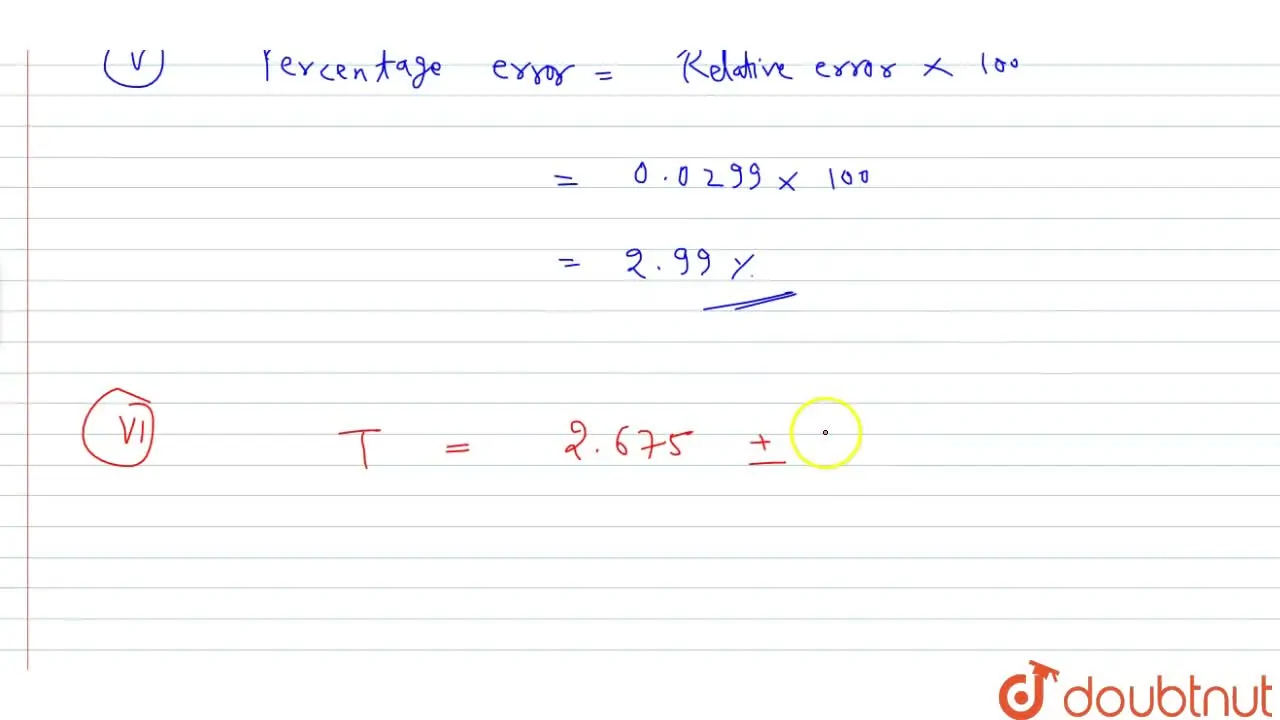In successive measurement, the reading of the period of oscillation of a simple pendulum were found to be 2.63s, 2.56s, 2.71s and 2.80s in an experiment. Calculate (i) mean value of the period oscillation (ii) absolute errer in each measurement (iii) mean absolute error (iv) releative error (v) percentage error and (vi) express the result in proper form.
The mean period of oscillation of the pendulum
T=(2.63+2.56+2.42+2.71+2.80)s5
=13.125s
=2.624s
=2.62s
As the periods are mesured to a resolution of 0.01 s, all times are to the second decimal, it is proper to put this mean period also to the second decimal.
The errors in the measurements are
2.63s−2.62s=0.01s
2.56s−2.62s=−0.06s
2.42s−2.62s=−0.20s
2.71s−2.62s=0.09s
2.80s−2.62s=0.18s
Note that the errors have the same units as the quantity to be measured.
The arithmatic mean of all the absolute errors (for arithmetic mean, we take only the magnitudes) is
ΔTmean=[(0.01+0.06+0.20+0.09+0.18)s]/5
=0.54s/5
=0.11s
That means, the period of oscillation of the simple pendulum is (2.62±0.11)s i.e. it lies between (2.62+0.11)s and (2.62−0.11)s or between 2.73 s and 2.51 s. As the arithmetic mean of all the absolute errors is 0.11 s, there is already an error in the tenth of a second. Hence there is no point in giving the period to a hyndredth. A more correct way will be to write
T=2.6±0.1s
Note that the last numeral 6 is unreliable, since it may be anything between 5 and 7. We indicate this by saying that the measurement has two significant figures. In this case, the two significant figures are 2, which is reliable and 6, which has an error associated with it. You will learn more about the significant figures in section 2.7.
For this example, the relative error or the percentage error is
δa=0.12.6×100=4%
Related Playlists
- BOOK - NCERTCHAPTER - UNITS AND MEASUREMENTEXERCISE - EXERCISE33videos
UNITS AND MEASUREMENT
- BOOK - NCERTCHAPTER - UNITS AND MEASUREMENTEXERCISE - QUESTION1videos
UNITS AND MEASUREMENT
- BOOK - NCERTCHAPTER - THERMODYNAMICSEXERCISE - EXERCISE10videos
THERMODYNAMICS
- BOOK - NCERTCHAPTER - WAVESEXERCISE - EXERCISE27videos
WAVES
Similar Questions
The diameter of a wire as measured by screw gauge was found to be 2.620, 2.625, 2.630, 2.628 and 2.626 cm. Calculate
(a) mean value of diameter (b) absolute error in each measurement
(c) mean absolute error (d) fractional error
(e) percentage error (d) (f) Express the result in terms of percentage errorView SolutionThe diameter of a wire as measured by a Screw gauge was found to be 1.328, 1.330, 1.325, 1.326, 1.334 and 1.336 cm. Calculate (i) mean value of diameter (ii) absolute error in each measurement (iii) mean absolute error (iv) fractional error (v) percentage error. Also, express the result in term of absolute error and percentage error.
View SolutionThe refractive index (n) of glass is found to have the values 1.49,1.50,1.52,1.54 and 1.48. Calculate
(i) the mean value of refractive index,
(ii) absolute error in each measurement,
(iii) mean absolute error,
(iv) fractional error and
(v) percentage errorView SolutionWhile determining the time period of oscillation of a simple pendulum, the readings from various measurements are 1.73s,1.62s,1.52s,1.45s and 1.83s. Calculate the values of mean value of time period, absolute error, mean absolute error and relative error.
View Solutionहम एक सरल लोलक कस दोलन - काल ज्ञात करते है । प्रयोग के क्रमिक मापनों में लिए गए पाठ्यांक हैं : 2.63 s, 2.56 s, 2.42 s, 2.71 s एवं 2.80 s । निरपेक्ष त्रुटि , सापेक्ष त्रुटि एवं प्रतिशत त्रुटि परिकलित कीजिए ।
View SolutionThe period of oscillation of a simple pendulum in the experiment is recorded as 2.63s,2.56s,2.42s,2.71s,and2.80s. Find the average absolute error.
View SolutionThe diameter of a wire as measured by a screw gauge was found to be 0.026 cm, 0.028 cm, 0.029 cm, 0.027cm, 0.024cm and 0.027 cm. Calculate
(i) mean value of diameter
(ii) mean absoulte error
(iii) relative error (iv) percentage error. Also express the result in terms of absolute error and percentage error.View SolutionIn an experiment, the values of refractive indices of glass were found to be 1.54,1.53,1.44,1.54,1.56 and 1.45 in successive measurements (i) mean value of refreactive index of glass (ii) mean absolute error (iii) relative error and (iv) percentage error are respectively.
View SolutionIn an experiment, the time period measurements for an oscillating simple pendulum are 2.10s, 2.12s, 2.23s, 2.62s and 2.92s. Find the relative error and absolute error in the experiment.
View SolutionIn an experiment the refractive index of glass was observed to be 1.45,1.56,1.54,1.44,1.54,and1.53. Calculate
(a). Mean value of refractive index
(b). Mean absolute error
( c ) Fractional error
(d) Percentage error
(e) Express the result in terms of absolute error and percentage errorView Solution


